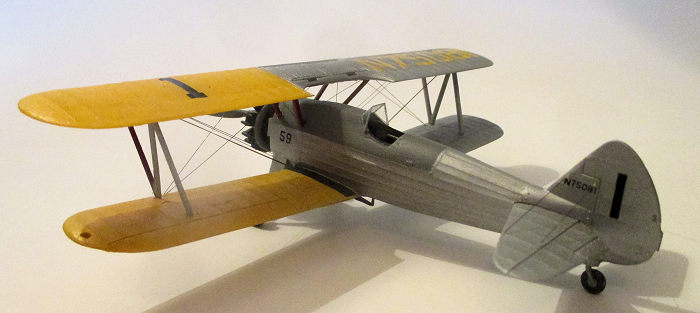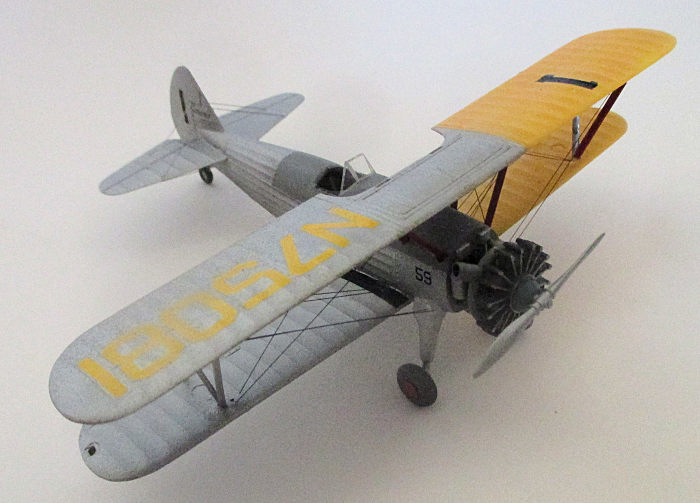
Revell 1/72 Stearman PT-17 Tanker
| KIT #: | H-649 |
| PRICE: | $inexpensive |
| DECALS: | One option |
| REVIEWER: | Brian Baker |
| NOTES: | Old kit with lots of development potential |

| HISTORY |
Nearly everyone is
familiar with the story of the Stearman-Boeing “Kaydet”, and I wrote an
article on the type back in Jan. 2010, so refer to it for details. Many
of these aircraft have had three careers (1) military trainer, (2)
agricultural aircraft, and (3) privately owned “warbirds”. After the
war, thousands were sold surplus for
 very
low prices, and most ended up as dusters or sprayers until the sixties,
when they began to be replaced by more efficient airplanes. Most were
rebuilt several times over their careers, and the smaller radial engines
were eventually replaced by P.W. R-985’s taken from inactive BT-13’s or
Beech C-45’s which littered civilian airports during the forties and
fifties.
very
low prices, and most ended up as dusters or sprayers until the sixties,
when they began to be replaced by more efficient airplanes. Most were
rebuilt several times over their careers, and the smaller radial engines
were eventually replaced by P.W. R-985’s taken from inactive BT-13’s or
Beech C-45’s which littered civilian airports during the forties and
fifties.
This particular Stearman, A75N1 (PT-17), N75081, serial 75-3182, is historic because it was the first airplane to be used commercially in the role of fire bomber. The even occurred in 1955, when Vance Nolta, pilot for Willows Flying Service, in Willows, CA, dropped either borate or water on a forest fire in the vicinity. The aircraft was later photographed by Aviation Historian William T. Larkins, and I used his photo for reference. At that time, 1964, the plane was one of the few to have a P.W. R-1340 600 hp. radial engine. The plane may be in a museum today. If not, it should be.
| THE KIT |
 This
kit has been around for a long time, first appearing about 1965. For many
years, it was the only Stearman available in 1/72 scale, although in recent
years, Pavla has issued a Stearman, and although I have one, I have never
built it. It is fairly typical of early Revell kits, with a fair amount of
detail, marginal fit, and quite poor engine detail. There are some problems
in wing/fuselage fit, and you should be prepared to use a fair amount of
putty to fill in the seams and imperfections. The lower wing needs added
dihedral, and the landing gear struts need a lot of work. There is almost no
cockpit detail, so you’ll have to add this yourself.
This
kit has been around for a long time, first appearing about 1965. For many
years, it was the only Stearman available in 1/72 scale, although in recent
years, Pavla has issued a Stearman, and although I have one, I have never
built it. It is fairly typical of early Revell kits, with a fair amount of
detail, marginal fit, and quite poor engine detail. There are some problems
in wing/fuselage fit, and you should be prepared to use a fair amount of
putty to fill in the seams and imperfections. The lower wing needs added
dihedral, and the landing gear struts need a lot of work. There is almost no
cockpit detail, so you’ll have to add this yourself.
| CONSTRUCTION |
 Construction
is not complicated, although you will need an accurate three view to get the
dihedral angle right. I would suggest painting the airframe first, as one
wet of wings is yellow, while the other wings are silver. The struts are
dull red, and these should certainly be painted before final assembly. A
cockpit interior is required, and since the engine is an R-1340, the unit
from a Monogram Curtiss F11C-2 works fine. The landing gear struts need
trimming, but they are useable. The forward cockpit needs to be filled in,
but this is relatively simple.
Construction
is not complicated, although you will need an accurate three view to get the
dihedral angle right. I would suggest painting the airframe first, as one
wet of wings is yellow, while the other wings are silver. The struts are
dull red, and these should certainly be painted before final assembly. A
cockpit interior is required, and since the engine is an R-1340, the unit
from a Monogram Curtiss F11C-2 works fine. The landing gear struts need
trimming, but they are useable. The forward cockpit needs to be filled in,
but this is relatively simple.
Other than the forward cockpit, the only change is the structure under the belly, which is part of the gate mechanism for the water release doors. The coloring seems strange, but that is what the color photos of the plane show. The “N” number and code (appropriately No. E-1) are in black. When completed, the model MUST be rigged to get the full biplane effect.
| CONCLUSIONS |
 If you are
tired of doing mundane military aircraft, this would be a good way to do
something different. There are a LOT of Stearmans, dusters, sprayer, tankers,
and other strange functions that can be modeled, and there is plenty of
information available on these.
If you are
tired of doing mundane military aircraft, this would be a good way to do
something different. There are a LOT of Stearmans, dusters, sprayer, tankers,
and other strange functions that can be modeled, and there is plenty of
information available on these.
24 October 2017
Copyright ModelingMadness.com
If you would like your product reviewed fairly and fairly quickly, please contact the editor or see other details in the Note to Contributors.
Back to the Main Page Back to the Review Index Page Back to the Previews Index Page